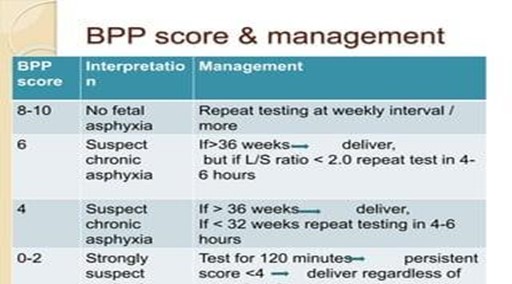A nurse is providing discharge instructions to a client who had a nonreactive nonstress test (NST) followed by a biophysical profile (BPP) with a score of 8/10.
Which of the following statements by the client indicates an understanding of the teaching?
“I will need to have another BPP in a week.”
“I will need to count my baby’s kicks every day.”
“I will need to have an amniocentesis as soon as possible.”
“I will need to deliver my baby by cesarean section.”.
The Correct Answer is B
The client should count the baby’s kicks every day to monitor fetal well-being. A nonreactive nonstress test (NST) indicates that the fetal heart rate did not increase adequately with fetal movement, which may suggest fetal hypoxia or distress. A biophysical profile (BPP) is a combination of NST and ultrasound that assesses five parameters: fetal breathing, movement, tone, amniotic fluid volume, and NST.
Each parameter is scored 0 or 2, and the total score ranges from 0 to 10. A score of 8/10 or 10/10 is considered normal, while a score of 6/10 is equivocal and ≤ 4/10 is abnormal. A BPP score of 8/10 with a nonreactive NST means that the fetus has normal biophysical activities but may have chronic hypoxia.
Choice A is wrong because the client does not need to have another BPP in a week unless there are other indications of fetal compromise. The BPP may be repeated once or twice a week depending on the clinical situation.
Choice C is wrong because the client does not need to have an amniocentesis as soon as possible.
Amniocentesis is an invasive procedure that involves inserting a needle into the uterus to obtain amniotic fluid for analysis. It is usually done for prenatal diagnosis of genetic disorders or fetal lung maturity, not for fetal well-being.
Choice D is wrong because the client does not need to deliver the baby by cesarean section. Cesarean section is a surgical delivery that may be indicated for various maternal or fetal conditions, such as placenta previa, breech presentation, fetal distress, or failure to progress in labor. A BPP score of 8/10 with a nonreactive NST does not warrant a cesarean section unless there are other risk factors or complications.

Nursing Test Bank
Naxlex Comprehensive Predictor Exams
Related Questions
Correct Answer is D
Explanation
Notify the provider and prepare for delivery.Oligohydramnios is a condition where the amniotic fluid volume is less than expected for gestational age and it is associated with maternal and fetal complications.
The nonstress test (NST) is a method of fetal surveillance that measures the fetal heart rate response to fetal movement.A reactive NST is defined as at least two accelerations of 15 beats per minute or more above the baseline, lasting 15 seconds or more, within a 20-minute period.
A nonreactive NST indicates fetal hypoxia or acidosis and requires further evaluation.An acoustic stimulator can be used to elicit fetal movement and accelerations, but it should not be repeated more than once in a 10-minute period.
Therefore, choice A is wrong because repeating the acoustic stimulation after 1 minute is too soon and may cause fetal distress.
Choice B is wrong because documenting the finding as a nonreactive NST is not enough to address the situation.Choice C is wrong because performing a contraction stress test (CST) is contraindicated in oligohydramnios because it may cause umbilical cord compression and fetal compromise.
The CST involves inducing uterine contractions with oxytocin or nipple stimulation and monitoring the fetal heart rate for signs of intolerance.
A negative CST means that there
Correct Answer is B
Explanation
NST is less time-consuming and more comfortable than CST.This is because NST does not require any external stimulation of the uterus, while CST involves giving oxytocin to induce contractions.NST also does not pose any risk of preterm labor or fetal distress, which are possible complications of CST.
Choice A is wrong because NST does not provide more information about fetal status than CST.In fact, CST can detect fetal hypoxia more accurately than NST.
Choice C is wrong because NST does not have fewer contraindications than CST.Both tests have similar contraindications, such as placenta previa, multiple gestation, and previous cesarean section.
Choice D is wrong because NST does not have higher sensitivity and specificity than CST.
Sensitivity refers to the ability of a test to correctly identify positive cases, while specificity refers to the ability of a test to correctly identify negative cases.
NST has a high sensitivity but a low specificity, meaning it can detect most fetuses with hypoxia but also has many false positives.CST has a low sensitivity but a high specificity, meaning it can miss some fetuses with hypoxia but also has few false negatives.
Whether you are a student looking to ace your exams or a practicing nurse seeking to enhance your expertise , our nursing education contents will empower you with the confidence and competence to make a difference in the lives of patients and become a respected leader in the healthcare field.
Visit Naxlex, invest in your future and unlock endless possibilities with our unparalleled nursing education contents today
Report Wrong Answer on the Current Question
Do you disagree with the answer? If yes, what is your expected answer? Explain.
Kindly be descriptive with the issue you are facing.
